Monographs: Pharmaceutical substances: Nirmatrelvir (Nirmatrelvirum)
Molecular formula. C23H32F3N5O4
Relative molecular mass. 499.54
Graphic formula.
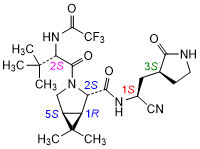
Chemical name. (1R,2S,5S)-N-{(1S)-1-Cyano-2-[(3S)-2-oxopyrrolidin-3-yl]ethyl}-3-[(2S)-3,3-dimethyl-2-(2,2,2-trifluoroacetamido)butanoyl]-6,6-dimethyl-3-azabicyclo[3.1.0]hexane-2-carboxamide (IUPAC); 3-Azabicyclo[3.1.0]hexane-2-carboxamide, N-[(1S)-1-cyano-2-[(3S)-2-oxo-3-pyrrolidinyl]ethyl]-3-[(2S)-3,3-dimethyl-1-oxo-2-[(2,2,2-trifluoroacetyl)amino]butyl]-6,6-dimethyl-, (1R,2S,5S)- (CAS).
CAS Registry Number. 2628280-40-8
Description. A white to pale coloured powder.
Solubility. It is freely soluble in dimethyl sulfoxide R and methanol R, soluble in acetonitrile R and dehydrated ethanol R, sparingly soluble in ethyl acetate R, slightly soluble in tert-butyl methyl ether R. It is practically insoluble in water R and heptane R.
Category. Antiviral.
Storage. Nirmatrelvir should be kept in tightly closed containers and protected from light.
Additional information. Nirmatrelvir exhibits polymorphism.
Requirements
Manufacture. The production method is validated to ensure that the substance, if tested, would comply with a limit of not more than 0.30 % for impurity R and 0.15 % for impurity D (nirmatrelvir enantiomer), using suitable methods.
Definition. Nirmatrelvir contains not less than 97.0% and not more than 102.0% of C23H32F3N5O4, calculated with reference to the anhydrous substance.
Identity tests
-
Either tests A and D or tests B, C and D may be applied.
-
Carry out the test as described under 1.7 Spectrophotometry in the infrared region. The infrared absorption spectrum is concordant with the spectrum obtained from nirmatrelvir RS or with the reference spectrum of nirmatrelvir.
If the spectra thus obtained are not concordant repeat the test using the residues obtained by separately dissolving the test substance and nirmatrelvir RS in tert-butyl methyl ether R and evaporating to dryness. The infrared absorption spectrum is concordant with the spectrum obtained from nirmatrelvir RS.
-
Carry out the test as described under 1.14.1 Chromatography, High-performance liquid chromatography, using the conditions given under "Assay". The retention time of the principal peak in the chromatogram obtained with solution (1) corresponds to the retention time of the peak due to nirmatrelvir in the chromatogram obtained with solution (2).
-
Carry out the test as described under 1.14.1 Chromatography, Thin-layer chromatography, using silica gel R5 as the coating substance and a freshly prepared mixture of ethyl acetate R and glacial acetic acid R (99:1 V/V) as the mobile phase. Apply separately to the plate 5 µL of each of the following two solutions in methanol R, containing (A) 2 mg per mL of the test substance and (B) 2 mg of nirmatrelvir RS per mL. After removing the plate from the chromatographic chamber, allow it to dry in air or in a current of air.
Spray the plate with anisaldehyde/methanol TS and heat it to 105 °C for 10 minutes. Allow the plate to cool and examine the chromatogram in daylight.
The principal spot in the chromatogram obtained with solution (A) corresponds in position, appearance, and intensity with the spot due to nirmatrelvir in the chromatogram obtained with solution (B).
-
Determine the specific optical rotation (1.4) using a solution containing 10.0 mg per mL of the test substance in methanol R. Calculate with reference to the anhydrous substance. The specific optical rotation
 is between -98.0 to -109.0.
is between -98.0 to -109.0.
Water. Determine as described under 2.8 Determination of water by the Karl Fischer method, Method A. Use 0.500 g of the test substance. The water content is not more than 5 mg/g.
Sulfated ash (2.3, Method B). Not more than 1.0 mg/g, determined on 1 to 2 g.
Heavy metals. Use 1.000 g for the preparation of the test solution as described under 2.2.3 Limit test for heavy metals, Procedure 3. Determine the heavy metals content according to Method B; not more than 20 μg/g.
Related substances. Carry out the test as described under 1.14.1 Chromatography, High-performance liquid chromatography, using a stainless steel column (2.1 mm x 15 cm) packed with end-capped particles of silica gel, the surface of which has been modified with chemically-bonded phenyl groups (1.8 µm).
Prepare a 0.1% methanesulfonic acid solutionby diluting 1.0 mL of methanesulfonic acid R to 1000 mL with water R.
Use the following conditions for gradient elution:
-
mobile phase A: 0.1% methanesulfonic acid solution,
-
mobile phase B: acetonitrile for chromatography R.
|
Time |
Mobile phase A |
Mobile phase B |
Comments |
|
0–1 |
95 |
5 |
Isocratic |
|
1–5 |
95 to 78 |
5 to 22 |
Linear gradient |
|
5-20 |
78 |
22 |
Isocratic |
|
20–25 |
78 to 59 |
22 to 41 |
Linear gradient |
|
25–35 |
59 to 30 |
41 to 70 |
Linear gradient |
|
35-35.5 |
30 |
70 |
Isocratic |
|
35.5–35.6 |
30 to 95 |
70 to 5 |
Return to initial composition |
|
35.6–42 |
95 |
5 |
Re-equilibration |
Operate with a flow rate of 0.48 mL per minute. Maintain the column temperature at 80 °C. To avoid excessive system pressure, first equilibrate at a lower flow rate of 0.1 mL/min until the column temperature reaches the set value and then increase the flow rate to 0.48 mL/min. After use, flush the column for at least 1 hour with a mixture of water R and acetonitrile R (50:50 V/V) at room temperature with a flow rate of 0.4 mL/min.
As a detector, use an ultraviolet spectrophotometer set at a wavelength of 205 nm. If configurable, operate with a reference wavelength at 400 nm.
Prepare the following solutions, using as a diluent a mixture of 50 volumes of water R and 50 volumes of acetonitrile R. For solution (1), transfer 55 mg of the test substance into a 50 mL volumetric flask, dissolve in about 30 mL and make up to volume. For solution (2), dilute 1.0 mL of solution (1) to 100.0 mL. For solution (3), dilute 5.0 mL of solution (2) to 100.0 mL. For solution (4), transfer 25 mg of nirmatrelvir RS into a 50 mL volumetric flask, add 5 mL of diluent and 2 mL of sodium hydroxide (~0.4 g/L) TS and mix. After 2 hours, dilute to volumewith a mixture of phosphate buffer, pH 7.0, TS and acetonitrile R, 50:50 (V/V), mixand filter. For solution (5), use the diluent.
Fill the solutions in polypropylene vials because degradation may occur with glass vials.
Inject 3 µL (if a 10 mm flow cell is used) or 5µL (if a 6 mm flow cell is used)each of solutions (1), (2), (3), (4) and (5).
Use the chromatogram obtained with solution (4) to identify the peaks due to the impurities O, B, I and F.
Use the chromatogram obtained with solution (5) to identify interferences from the blank and system peaks.
The impurities are eluted, if present, at the following relative retentions with reference to nirmatrelvir (retention time about 21 minutes): impurity N about 0.04; impurity O about 0.29; impurity B about 0.56; impurity I about 0.65; impurity A about 0.83; impurity G about 0.92; impurity H about 0.92; impurity Q about 0.92 (impurities G, H and Q co-elute); impurity F about 0.98; impurity J about 1.09; impurity K about 1.18; impurity L about 1.23; impurity M about 1.34; impurity C about 1.41.
The test is not valid unless in this chromatogram obtained with solution (4) the peak-to-valley ratio (Hp/Hv) is at least 2.0, where Hp is the height above the baseline of the peak due to impurity F and Hv is the height above the baseline of the lowest point of the curve separating this peak from the peak due to nirmatrelvir.Also, the test is not valid unless in the chromatogram obtained with solution (3), the peak due to nirmatrelvir is obtained with a signal-to-noise ratio of at least 10.
In the chromatogram obtained with solution (1):
-
the area of any peak corresponding to impurity J is not greater than 0.5 times the area of the peak due to nirmatrelvir in the chromatogram obtained with solution (2) (0.5 %);
-
the area of any peak corresponding to impurity M, is not greater than 0.3 times the area of the peak due to nirmatrelvir in the chromatogram obtained with solution (2) (0.3 %);
-
the area of any peak corresponding to impurity I is not greater than 0.25 times the area of the peak due to nirmatrelvir in the chromatogram obtained with solution (2) (0.25 %);
-
the areas of any peak corresponding to impurities A, B, C, K, L, N or O are each not greater than0.15 times the area of the peak due to nirmatrelvir in the chromatogram obtained with solution (2) (0.15 %);
-
the sum of the areas of any peaks corresponding to impurities G, H and Q is not greater than 0.15 times the area of the peak due to nirmatrelvir in the chromatogram obtained with solution (2) (0.15 %);
-
the area of any other impurity peak is not greater than 0.10 times the area of the peak due to nirmatrelvir in the chromatogram obtained with solution (2) (0.10 %).
-
The sum of the areas of all impurity peaks is not greater than twice the area of the peak due to nirmatrelvir in the chromatogram obtained with solution (2) (2.0 %). Disregard all peaks with an area of less than the area of the peak due to nirmatrelvir in the chromatogram obtained with solution (3) (0.05 %).
Assay. Carry out the test as described under 1.14.1 Chromatography, High-performance liquid chromatography, using the conditions given above under "Related substances".
Prepare the following solutions, using as a diluent a mixture of 50 volumes of water R and 50 volumes of acetonitrile R. For solution (1), dissolve 55.0 mg of the test substance and dilute to 50.0 mL. For solution (2), dissolve 55.0 mg of nirmatrelvir RS and dilute to 50.0 mL.
Inject 3 µL (if a 10 mm flow cell is used) or 5 µL (if a 6 mm flow cell is used)each of solutions (1) and (2).
Measure the areas of the peaks corresponding to nirmatrelvir obtained in the chromatograms of solutions (1) and (2) and calculate the percentage content of Nirmatrelvir (C23H32F3N5O4) in the sample using the declared content of C23H32F3N5O4 in nirmatrelvir RS.
Impurities
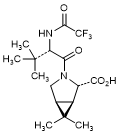
A. (1R,2S,5S)-3-[(2S)-3,3-Dimethyl-2-(2,2,2-trifluoroacetamido)butanoyl]-6,6-dimethyl-3-azabicyclo[3.1.0]hexane-2-carboxylic acid (process related impurity),
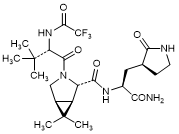
B. (1R,2S,5S)-N-{(2S)-1-Amino-1-oxo-3-[(3S)-2-oxopyrrolidin-3-yl]propan-2-yl}-3-[(2S)-3,3-dimethyl-2-(2,2,2-trifluoroacetamido)butanoyl]-6,6-dimethyl-3-azabicyclo[3.1.0]hexane-2-carboxamide (synthesis related impurity and degradation product),
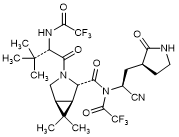
C. (1R,2S,5S)-N-{(1S)-1-Cyano-2-[(3S)-2-oxopyrrolidin-3-yl]ethyl}-3-[(2S)-3,3-dimethyl-2-(2,2,2-trifluoroacetamido)butanoyl]-6,6-dimethyl-N-(trifluoroacetyl)-3-azabicyclo[3.1.0]hexane-2-carboxamide (synthesis related impurity),
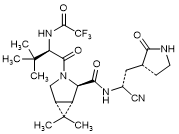
D. (1S,2R,5R)-N-{(1R)-1-Cyano-2-[(3R)-2-oxopyrrolidin-3-yl]ethyl}-3-[(2R)-3,3-dimethyl-2-(2,2,2-trifluoroacetamido)butanoyl]-6,6-dimethyl-3-azabicyclo[3.1.0]hexane-2-carboxamide (enantiomer of nirmatrelvir)(synthesis related impurity),
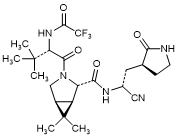
F. (1R,2S,5S)-N-{(1R)-1-Cyano-2-[(3S)-2-oxopyrrolidin-3-yl]ethyl}-3-[(2S)-3,3-dimethyl-2-(2,2,2-trifluoroacetamido)butanoyl]-6,6-dimethyl-3-azabicyclo[3.1.0]hexane-2-carboxamide (diastereomer/epimer of nirmatrelvir) (synthesis related impurity and degradation product),
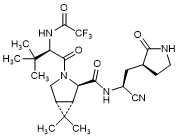
G. (1S,2R,5R)-N-{(1S)-1-Cyano-2-[(3S)-2-oxopyrrolidin-3-yl]ethyl}-3-[(2R)-3,3-dimethyl-2-(2,2,2-trifluoroacetamido)butanoyl]-6,6-dimethyl-3-azabicyclo[3.1.0]hexane-2-carboxamide (diastereomer of nirmatrelvir)(synthesis related impurity),
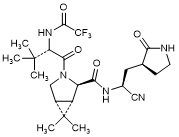
H. (1S,2R,5R)-N-{(1S)-1-Cyano-2-[(3S)-2-oxopyrrolidin-3-yl]ethyl}-3-[(2S)-3,3-dimethyl-2-(2,2,2-trifluoroacetamido)butanoyl]-6,6-dimethyl-3-azabicyclo[3.1.0]hexane-2-carboxamide (diastereomer of nirmatrelvir)(synthesis related impurity),
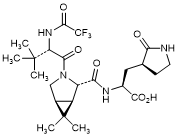
I.(2S)-2-({(1R,2S,5S)-3-[(2S)-3,3-Dimethyl-2-(2,2,2-trifluoroacetamido)butanoyl]-6,6-dimethyl-3-azabicyclo[3.1.0]hexane-2-carbonyl}amino)-3-[(3S)-2-oxopyrrolidin-3-yl]propanoic acid (synthesis related impurity and degradation product),
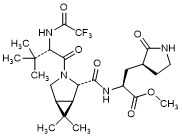
J. Methyl (2S)-2-({(1R,2S,5S)-3-[(2S)-3,3-dimethyl-2-(2,2,2-trifluoroacetamido)butanoyl]-6,6-dimethyl-3-azabicyclo[3.1.0]hexane-2-carbonyl}amino)-3-[(3S)-2-oxopyrrolidin-3-yl]propanoate (synthesis related impurity),
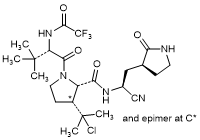
K.(2S)-3-(2-Chloropropan-2-yl)-N-{(1S)-1-cyano-2-[(3S)-2-oxopyrrolidin-3-yl]ethyl}-1-[(2S)-3,3-dimethyl-2-(2,2,2-trifluoroacetamido)butanoyl]pyrrolidine-2-carboxamide(synthesis related impurity),
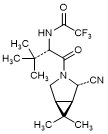
L. N-{(2S)-1-[(1R,2S,5S)-2-Cyano-6,6-dimethyl-3-azabicyclo[3.1.0]hexan-3-yl]-3,3-dimethyl-1-oxobutan-2-yl}-2,2,2-trifluoroacetamide (synthesis related impurity),
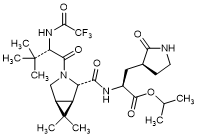
M. Propan-2-yl (2S)-2-({(1R,2S,5S)-3-[(2S)-3,3-dimethyl-2-(2,2,2-trifluoroacetamido)butanoyl]-6,6-dimethyl-3-azabicyclo[3.1.0]hexane-2-carbonyl}amino)-3-[(3S)-2-oxopyrrolidin-3-yl]propanoate (synthesis related impurity),

N. (2S)-2-Amino-3-[(3S)-2-oxopyrrolidin-3-yl]propenamide ,
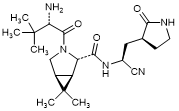
O. (1R,2S,5S)-N-{(1S)-1-Cyano-2-[(3S)-2-oxopyrrolidin-3-yl]ethyl}-6,6-dimethyl-3-(3-methyl-L-valyl)-3-azabicyclo[3.1.0]hexane-2-carboxamide (degradation product),
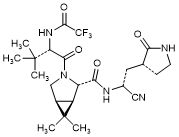
Q.(1R,2R,5S)-N-{(1R)-1-Cyano-2-[(3R)-2-oxopyrrolidin-3-yl]ethyl}-3-[(2S)-3,3-dimethyl-2-(2,2,2-trifluoroacetamido)butanoyl]-6,6-dimethyl-3-azabicyclo[3.1.0]hexane-2-carboxamide (diastereomer/epimer of nirmatrelvir),
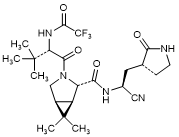
R. (1R,2S,5S)-N-{(1S)-1-Cyano-2-[(3R)-2-oxopyrrolidin-3-yl]ethyl}-3-[(2S)-3,3-dimethyl-2-(2,2,2-trifluoroacetamido)butanoyl]-6,6-dimethyl-3-azabicyclo[3.1.0]hexane-2-carboxamide.